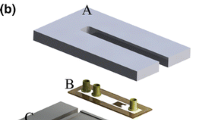Abstract
A highly sensitive thermal measurement device based on a vanadium oxide (VOx) microthermistor is developed for detecting biological molecules based on enzymatic reactions. The measurement principle of the VOx thermistor relies on the temperature dependence of its electrical resistance owing to the heat generation of enzymatic reactions. The device comprises a microfluidic channel and chambers, and VOx thermistors on a suspended Si3N4 membrane for thermal insulation. The enzyme is immobilized in silica gel on the sensor. The temperature coefficient of the resistance of the fabricated VOx thermistor is −1.3 %/K. The fabricated device has a temperature resolution of 0.30 mK/√Hz and a temperature response of 4.9 mV/K. Thermal measurements of cholesterol and glucose are demonstrated using the heat production caused by enzymatic reactions. The detectable concentrations of glucose and cholesterol were 30 and 15 µM/√Hz, respectively.









Similar content being viewed by others
References
Biermann S, Poteryaev A, Lichtenstein AI, Georges A (2005) Dynamical singlets and correlation-assisted peierls transition in VO2. Phys Rev Lett 94(2):026404
Chain EE (1986) The influence of deposition temperature on the structure and optical properties of vanadium oxide films. J Vac Sci Technol A 4(3):432–435
Chancellor EB, Wikswo JP, Baudenbachera F (2004) Heat conduction calorimeter for massively parallel high throughput measurements with picoliter sample volumes. Appl Phys Lett 85(12):2408–2410
Chen C, Yi X, Zhao X, Xiong B (2001) Characterizations of VO2-based uncooled microbolometer linear array. Sens Act A 90(3):212–214
Chi-Anh N, Moon S (2007) Excess noise in vanadium tungsten oxide bolometric material. Infrared Phys Technol 50(1):38–41
Chi-Anh N, Shin HJ, Kim K, Han YH, Moon S (2005) Characterization of uncooled bolometer with vanadium tungsten oxide infrared active layer. Sens Act A 123–124:87–91
Davaji B, Lee CH (2014) A paper-based calorimetric microfluidics platform for bio-chemical sensing. Biosens Bioelectron 59:120–126
Davaji B, Bak HJ, Chang WJ, Lee CH (2014) A novel on-chip three-dimensional micromachined calorimeter with fully enclosed and suspended thin-film chamber for thermal characterization of liquid samples. Biomicrofluidics 8:034101-1-03401-13
De Natale JF, Hood PJ, Harker AB (1989) Formation and characterization of grain-oriented VO2 thin films. J Appl Phys 66:5844–5850
Eyert V (2011) VO2: a novel view from band theory. Phys Rev Lett 107(1):016401
Garden JL, Chateau E, Chaussy J (2004) Highly sensitive ac nanocalorimeter for microliter-scale liquids or biological samples. Appl Phys Lett 84(18):3597–3599
Gurvitch M, Luryi S, Polyakov A, Shabalov A, Dudley M, Wang G, Ge S, Yakovlev V (2007) VO2 films with strong semiconductor to metal phase transition prepared by the precursor oxidation process. J Appl Phys 102(3):033504
Han YH, Kim KT, Shin HJ, Moon S, Choi IH (2005) Enhanced characteristics of an uncooled microbolometer using vanadium–tungsten oxide as a thermometric material. Appl Phys Lett 86(25):254101
Jiang SJ, Ye CB, Khan MSR, Granqvist C-G (1991) Evolution of thermochromism during oxidation of evaporated vanadium films. Appl Opt 30(7):847–851
Johannessen EA, Weaver JMR, Bourova L, Svoboda P, Cobbold PH, Cooper JM (2002) Micromachined nanocalorimetric sensor for ultra-low-volume cell-based assays. Anal Chem 74:2190–2197
Kohin M, Butler NR (2004) Performance limits of uncooled VOx microbolometer focal plane arrays. Proc. SPIE 2004(5406):447–453
Kumar A, Malhotra R, Malhotra BD, Grover SK (2000) Co-immobilization of cholesterol oxidase and horseradish peroxidase in a sol-gel film. Anal Chim Acta 414(1–2):30–50
Lee J, Spadaccini CM, Mukerjee EV, King WP (2008) Differential scanning calorimeter based on suspended membrane single crystal silicon microhotplate. J Microelectromechs 17(6):1513–1523
Lee W, Fon W, Axelrod BW, Roukes ML (2009) High-sensitivity microfluidic calorimeters for biological and chemical applications. PNAS 106(36):15225–15230
Olson EA, Efremov MYu, Kwan AT, Lai S, Petrova V, Schiettekatte F, Warren JT, Zhang M, Allen LH (2000) Scanning calorimeter for nanoliter-scale liquid samples. Appl Phys Lett 77(17):2671–2673
Rice TM, Launois H, Pouget JP (1994) Comment on “VO2: peierls or Mott-Hubbard? A view from band theory”. Phys Rev Lett 73(22):3042
Serway RA (1998) “Principles of physics” 2nd edn., Fort Worth, Texas; London: Saunders College Pub. ISBN 0-03-020457-7
Verhaegen K, Baert K, Simaels J, Driessche WV (2000) A high-throughput silicon microphysiometer. Sens. Act 82:186–190
Vutha AK, Davaji B, Lee CH, Walker GM (2014) A microfluidic device for thermal particle detection. Microfluid Nanofluid 17(5):871–878
Wada H, Nagashima M, Shima T, Hijikawa M, Oda N (1997) “256 × 256 uncooled microbolometer focal plane array. T IEE Japan 117(E12):612–616
Wang L, Wang B, Lin Q (2008) Demonstration of MEMS-based differential scanning calorimetry for determining thermodynamic properties of biomolecules. Sens Act B 134:953–958
Zhang Y, Tadigadapa S (2004a) Calorimetric biosensors with integrated microfluidic channels. Biosens Bioelectron 19:1733–1743
Zhang Y, Tadigadapa S (2004b) Thermal characterization of liquids and polymer thin films using a microcalorimeter. Appl Phys Lett 86:034101
Zylbersztejn A, Mott NF (1975) Metal-insulator transition in vanadium dioxide. Phys Rev B 11(11):4383–4395
Acknowledgments
Part of this study was performed at the Micro/Nanomachining Research Education Center and the Nishizawa Center of Tohoku University. This study was supported in part by JSPS KAKENHI Grant Number 15K17450, and also supported in part by Special Coordination Funds for Promoting Science and Technology, Formation of Innovation Center for Fusion of Advanced Technologies.
Author information
Authors and Affiliations
Corresponding author
Rights and permissions
About this article
Cite this article
Inomata, N., Pan, L., Wang, Z. et al. Vanadium oxide thermal microsensor integrated in a microfluidic chip for detecting cholesterol and glucose concentrations. Microsyst Technol 23, 2873–2879 (2017). https://doi.org/10.1007/s00542-016-3090-1
Received:
Accepted:
Published:
Issue Date:
DOI: https://doi.org/10.1007/s00542-016-3090-1




